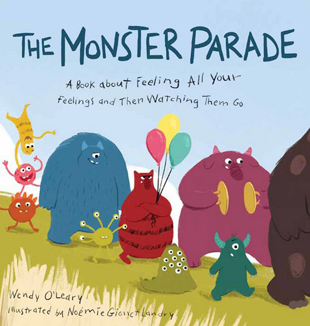Guiding children to understand their feelings and not get stuck in them is a matter of greater consequence than we sometimes realize. Disruptive emotions, said Lama Thubten Yeshe, "are responsible for all the conflict in the world, from two small children fighting over a piece of candy to two huge nations fighting over their very existence."
Wendy O'Leary — an educator and public speaker who teaches emotional intelligence skills — uses a parade analogy in her work, her own life, and this book to help children and all of us learn how to let emotions come and go. This book looks in particular at anger, sadness, and fear. Often overwhelming and scary, these feelings lend themselves to portrayal as monsters on parade.
O'Leary not only tells how to view emotions as passing through, but also how to identify them (e.g. "your body feels tight and you just want to scream" or "a lump in your throat"), avoid jumping into the parade ("your breath keeps you here"), and call to mind countering emotions:
"Just remember a time you felt
happy and bright.
After you notice hard feelings
it will help you feel light."
Pictures by Noémie Gionet Landry show children of various ethnicities dealing with child-friendly monsters who may appear huge and alarming at first: like blue-gray Sadness lumbering over the horizon with horns and a cyclops eye. After the practice of following the breath in and then out, though, Sadness can be seen retreating down the street while holding balloons. Similarly, the monsters wave at the children and even, in one picture, comfortingly hold a child close while sitting together contemplating an ocean view.
The book's narrative portion is rounded out by a helpful discussion of why practices are important and by descriptions of six exercises to try: Name It to Tame It, Feel It in Your Body, Feet on the Floor, Use the Parade Idea, Belly Breath, and Counting Breath. They're carefully tailored for three to seven year olds.
The closing Author's Note reminds us that "the parade works for grown-ups, too!" She has found the parade analogy helpful in her own life: "For example, when I notice I am feeling worried, I remember the parade and see a googly-eyed Worry creature. Then I say to myself, 'Yes, I see you. And you can continue along the parade now.' " May this book help many children and their caregivers discover ways to live in peace and harmony, helping our world to heal.
